An oasis of art in the back streets of Tel Aviv, Tmuna Theatre hosted the Intimadance Festival this past weekend, under the artistic direction of Rotem Tashach and Inbal Yaakobi, taking a look at “The Movement of the Everyday” from a choreographic perspective.
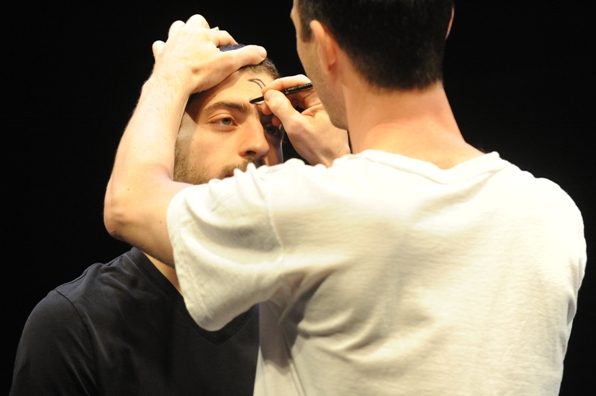
In the festive Tmuna tradition, the venue itself becomes part of the show, with visual references to the works studded throughout the corridors, bar and foyer. Most striking: the area under the stairs at the bar was lavishly dedicated to Hillel Kogan’s Ohavim Aravim (Loving Arabs). The corner was comfortably filled with cushions, a small boom box blared Arabic music, and a low table was set with a nargilla and a silver bowl full of hummus, with a plate of pita on the side, along with a small bowl of sunflower seeds. Very inviting! Mesmerizing is the word I’d choose for the installation relating to Maya Brinner’s work Nisuyim Be’Hipnosa (Experiments in Hypnosis) – an excellent quality projection of Loie Fuller dancing on a red upholstered chair. The woman dancing, sculptural waves of cloth billowing around her, shifting shape as she moves – it’s an evocative image even for those unaware of the American who made her way from burlesque to the Folies Bergère, making a profound impression on the poets and artists of her time with the effects created in her dances.
The performances themselves take place in different rooms within the venue, resulting in a certain amount of scrambling for places with each move, and a brief, invigorating walk before each short piece.
Ariel Bronz and Bar Eltras evoked the small movements and moments of a couple’s relationship, set against the backdrop of hard times and empty pockets, exploring the question of comfort/discomfort. Ordinary moments keenly observed were very effective. The couple, sitting side by side in two chairs, looking straight ahead. She looks at him, he spies her looking out of the corner of his eye and begins to look her way as she immediately senses his awareness and looks away. Holding hands, a gesture of intimacy that can turn into a playful swinging of their arms, or dissipate as one loosens the hold and the other lets go. All this conveyed with humor and without neglecting all that is hidden under the rug…
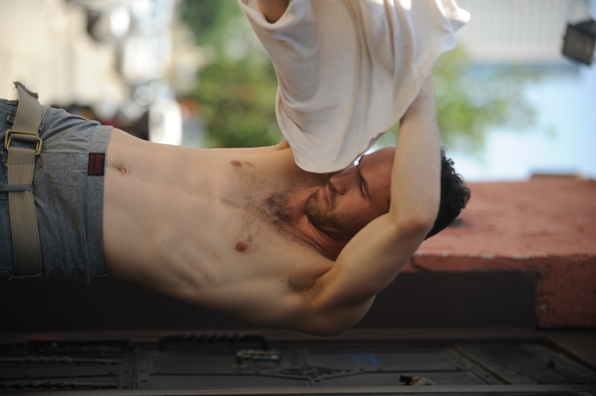
Tal Shibi took a wild ride through the male wardrobe, minus his pants. Standing with his back to the audience, clad in a button down shirt and jeans jacket, Shibi slipped in and out of the jacket in a continuous circular movement, beautiful to watch and an apt introduction to this opening up of the process of dressing, undressing, choice of garment and ways of entering or departing from the routine codes, manners and movements. Ultimately, encased in a shimmering red cloth, he emerged nude, his arms gently testing the air in a fetal-like motion, as if he was somehow born anew.
Hameragelet Rut (Ruth the Spy) had me intrigued yet perplexed. Performed by Asher Lev and Ruth Valensi, he held a large log and saw, she – a large hammer. The relationship between the two onstage ranged from distance to an almost erotic proximity to a plethora of positions and situations, culminating in the “spy” mounted on the stake, as if ready for burning.
Saar Skeley presented his face through an opening in a large white curtain that functioned as a screen, delivering a monologue on his thoughts and experiences as a participant on the reality television show HaAh HaGadol – the Israeli version of Big Brother, while scenes from the show were projected on the curtain. Not an aficionado of reality television, full disclosure compels me to reveal that I have never once seen HaAh HaGadol, and perhaps that is why this performance eluded my interest.
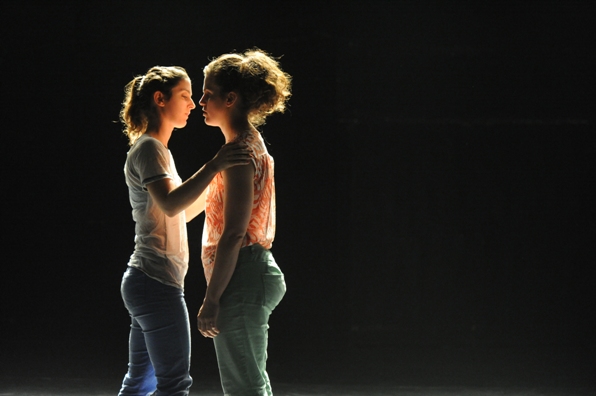
Maayan Horesh and Nitzan Lederman put word and gesture together with wit and humor, in Miss Catch, creating a funny yet poignant vignette of two friends and shifting balance. As Nitzan wavered and wobbled, occasionally falling, Maayan watched, then came to help her up. She stood at ready, steadying her falling friend each time Nitzan listed to one side, breaking her fall. After a minute or so, the unsteady friend said, literally – in colloquial Hebrew: I’m so sorry to keep falling on you like this. (אני מה זה מצטערת שאני נופלת עליך ככה)
Olivia Court Mesa presented her work Tzomet (Junction) on the larger stage of the “Hanaya” (a former parking area converted to a stage). Smiling musicians and a lovely vocalist, equipped with ukelele and flute performed a remarkably upbeat rendition of P. J. Harvey’s Soldier (arranged by Isidoro Abramowicz), then a diverse cast – including non-dancers, each walked/danced what the choreographer describes as “the rhythm of daily life” – each alone, yet all occupying the same space, meeting, interacting, affecting one another.
Gabrielle Neuhaus did something delightfully different – a solo entitled Barcode, presenting the choreography of a woman entering a bar alone. The thoughts and gestures of hesitation and desire, the decision to enter or not, once in – where to go, how to stand, how to move, where to look… and in the struggle with desperation, discomfort and desire, ending in a bold dance of bravado!
Perhaps it is a commentary on the dialogue between choreographer/performer and viewer that the two works I found most striking were those of choreographers whose work I have come to know over time. Something to ponder.
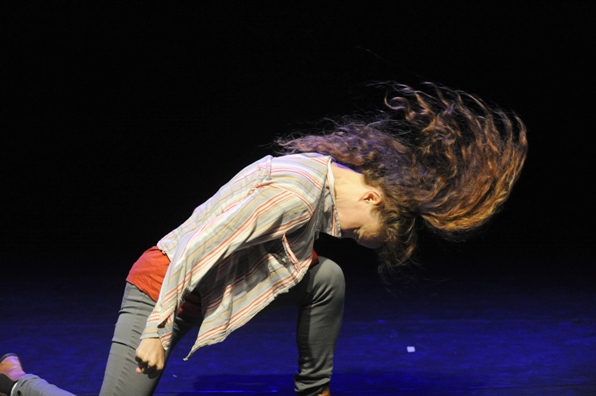
Maya Brinner performed Nisuyim Be’Hipnosa (Experiments in Hypnosis) in a red shirt and jeans, long red hair covering her face entirely. Legs apart, she stood on tip toe, rocking, shifting her balance from one leg to the other, then with a snap of her fingers she began to dance, moving her hips in large, undulating circles, down into a deep plie – until at some point she swept the hair off her face and directing a steady look at the audience said, “We are in the midst of an experiment. I see you seeing me move.” One finger pointed in the air, like a warning or direction, the other tracing a line down her body, until she says, “Nothing here is personal. You see me as a moving body.”
A choreographer whose work often employs and reflects upon repeated motions, here too, a repeated motion intensifies and develops, leading into another shape or kind of motion, with, as the title of the work implies, a mesmerizing effect which was undercut by her pointed commentary: “You may ask questions, you may imagine you see images that may become full of meaning…that’s too bad.” It was a visually fascinating performance that did spark a multitude of images and thoughts – not the least of which is the relationship between the exposed position of the dancer onstage and the question of what is revealed, what is concealed, and in this act of hypnosis or seduction, who is in control?
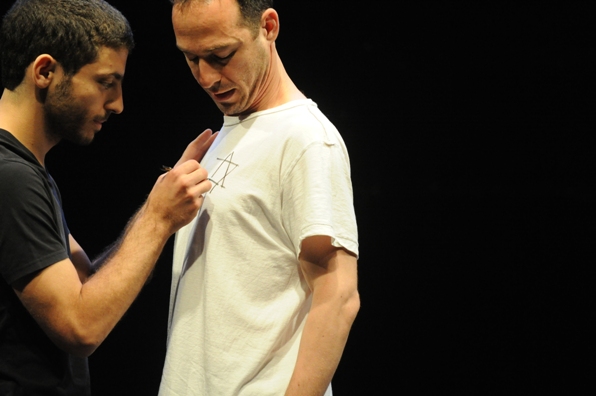
Loving Arabs (Ohavim Aravim), by Hillel Kogan, takes the elephant in the enlightened parlors of the cultural left (as Hillel tossed off nonchalantly during the performance – the typical Tmuna audience) and dances with it – to great effect. Speaking in terms of choreography about the relationship of his body to the space, alluding in fairly transparent terms to the geo-political situation in Israel, Hillel created a dance that is also self-referential in terms of the dance world, the process of creating a piece and choreographer – dancer relationships.
In the midst of creating a new work, Hillel, in the role of the ‘choreographer’ pauses and shares his thoughts with the audience. Saying: “my body feels that there are areas that are not mine” – he realizes what is missing in his new piece: an Arab. Hillel auditions and rehearses a piece on “co-existence” with the token “Arab” he has found – dancer Adi Boutrous playing the ingénue with just the right look of askance – creating a work that reflects in text and movement the complexities and hypocrisies of the situation. A seriously funny work that touches every exposed nerve, I loved Ohavim Aravim!
For all those who missed the fun, Roy Herzlich’s video will give you an idea of what Intimadance is all about – Enjoy!

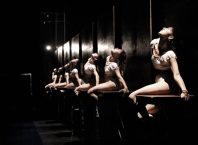
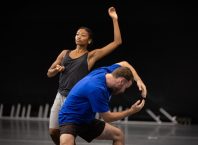
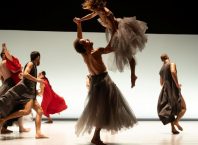


Comments are closed.